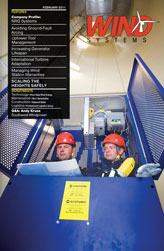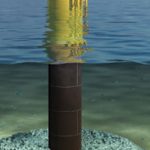The grounding transformer is an often-neglected component of the wind farm, shunted off to a sidebar issue. However, those who neglect to adequately plan for grounding transformers do so at their peril. In reality, millions of dollars in liability and loss can be attributed to ground-fault arcing, so grounding-related issues should top the checklists of any electrical contractor developing a wind farm.
Proper construction to meet the specific needs of wind farms is absolutely essential. In addition, be sure your grounding transformer considers such essential parameters as primary voltage, the size needed to carry the rated continuous primary phase current without exceeding temperature limits, and fault current and duration. Finally, select from among the variety of options available based on the application’s site-specific needs.
What is a Grounding Transformer?
Simply put, a grounding transformer is used to provide a ground path to either an ungrounded Wye or a delta-connected system. Grounding transformers are typically used to provide a relatively low impedance path to the ground, thereby maintaining the system neutral at or near ground potential; to limit the magnitude of transient over-voltages when re-striking ground faults occur; to provide a source of ground fault current during line-to-ground faults; and to permit the connection of phase to neutral loads when desired.
If a single line-to-ground fault occurs on an ungrounded or isolated system, no return path exists for the fault current, so no current flows. The system will continue to operate, but the other two un-faulted lines will rise in voltage by the square root of three, resulting in overstressing of the transformer insulation and other associated components on the system by 173 percent. Metal Oxide Varistors (MOVs)—solid state devices used to suppress voltage surges/spikes (lightning arresters)—are particularly susceptible to damage from heating by leakage across the blocks, even if the voltage increase is not sufficient to flash over. A grounding transformer provides a ground path to prevent this.
Grounding transformers are essential for large multi-turbine wind farms, where the substation transformer frequently provides the sole ground source for the distribution system. A grounding transformer placed on the turbine string provides a ground path in the event the string becomes isolated from the system ground.
When a ground fault on a collector cable causes the substation circuit breaker for that cable to open, the wind turbine string becomes isolated from the ground source. The turbines do not always detect this fault or the fact that the string is isolated and ungrounded. The generators continue to energize the collector cable, and the voltages between the un-faulted cables and the ground rise far above the normal voltage magnitude. The resulting costs can be staggering. The loss of revenue alone for a string of 10 turbines can exceed $10,000 per day. Considering removal and replacement, costs of equipment could approach an additional $40,000 per transformer.
For example, a typical wind farm configuration is somewhat analogous to a carriage wheel with a ring, hub, and spokes. The wheel’s outer ring is like the fence around the wind farm and the hub in the center is where the collector is located, which connects to the grid. The spokes are radial lines where each wind turbines sit. Typically each radial string of turbines will connect to a grounding transformer. Figure 1 provides a generalized diagram of this layout.
Construction Configurations
Grounding transformers are normally constructed with one of two configurations: a Zig-Zag (Zn)-connected winding with or without an auxiliary winding, or a Wye (Ynd)-connected winding with a delta-connected secondary that may or may not be used to supply auxiliary power. Figure 2 shows these two possible configurations. The current trend in wind farm designs is toward the Wye-connected primary with a delta secondary (Figure 2b). There are several reasons why the two-winding Wye-connected grounding transformers are seemingly more popular than Zig-Zag designs:
• Though not actually the case, two-winding transformers are perceived to be more readily available for replacement or upgrade;
• Lack of familiarity with the design basics required for the Zig-Zag configuration means designers tend to fall back on the more familiar configuration;
• The Wye-connected two-winding design allows for secondary loading and metering while Zig-Zag designs do not;
• Not all manufacturers provide Zig-Zag grounding options to potential customers, even those for whom that configuration might be most appropriate.
The Zig-Zag connection’s geometry (Figure 2a) is useful to limit circulation of third harmonics and can be used without a delta-connected winding or the four- or five-leg core design normally used for this purpose in distribution and power transformers. Eliminating the need for a secondary winding can make this option both less expensive and smaller than a comparable two-winding grounding transformer. Furthermore, use of a Zig-Zag transformer provides grounding with a smaller unit than a two-winding Wye-Delta transformer providing the same zero sequence impedance.
Wye-connected grounding transformers, on the other hand, require either a Delta-connected secondary or the application of four- or five-leg core construction to provide a return flux path for unbalanced loading associated with this primary connection. Since it is often desirable to provide auxiliary power from the grounding transformer secondary winding, this benefit may make it preferable to use a two-winding grounding transformer instead of a Zig-Zag connection. Both Zig-Zag and two-winding grounding transformers can be constructed with auxiliary power capabilities, and this can be either a Wye- or Delta-connected load.
A solidly grounded system using a grounding transformer offers many safety improvements over an ungrounded system. However, the ground transformer alone lacks the current limiting ability of a resistive grounding system. For this reason neutral ground resistors are often used in conjunction with the grounding transformer to limit neutral ground fault current magnitude. Their ohm values should be specified to allow high enough ground fault current flow to permit reliable operation of the protective relaying equipment, but low enough to limit thermal damage.
Essential Parameters
When selecting and specifying a grounding transformer for your wind farm, be sure to consider the following key parameters.
Primary voltage—This is the system voltage to which the grounded winding is to be connected. Don’t forget to specify the transformer’s basic impulse level (BIL), which measures its ability to withstand lightning surges. In some cases the BIL will be dictated by equipment considerations, such as 150 kilovolt (kV) BIL ratings on 34500 volt wind farms, because of the limitation on dead front connectors.
Rated kilo-volt amperes (kVA)—Because the grounding transformer is normally a short time device, its size and cost are less compared to a continuous duty transformer of equal kVA rating. For this reason grounding transformers are often not sized by kVA, but by their continuous and short time current ratings. Regardless of how you rate it, the grounding transformer must be sized to carry the rated continuous primary phase current without exceeding its temperature limit. This load includes the magnetizing current of the core, the capacitive charging current for the cables, and any auxiliary load, if applicable. The higher this value, the larger and more costly the transformer will be. Typical continuous current values can be as low as 5 amps to as high as a few hundred. Be sure to include any auxiliary loading requirements.
Continuous neutral current—The continuous neutral current is defined as three times the phase to current. Or, in other words, the zero sequence current. This is usually considered to be zero if the system is balanced. However, for the purposes of designing a grounding transformer, it is a value that is expected to flow in the neutral circuit without tripping protective circuits (which would force the current to be zero) or the leakage current to ground that is not a symmetrical function. Again this value is needed to design for thermal capacity of the grounding transformer.
Fault current and duration—This value is needed to calculate the short time heating that results from a fault on the system and should be determined from an engineered system study. Typical values range from a few hundred amps to a few thousand amps, with duration times expressed in seconds and not cycles. For instance, a value of 400 amps for 10 seconds is typical. The fault duration is a critical parameter for the transformer designer. Where protection schemes use the grounding transformer for tripping functions, a relatively short time duration is specified (5-10 seconds). On the other hand, a continuous or extended neutral fault current duration would be required when the grounding transformer is used in a ground fault alarm scheme.
Impedance—The impedance can be expressed as a percentage or as an ohm value per phase. In either case it should be chosen so that the un-faulted phase voltages during a ground fault are within the temporary over-voltage capability of the transformer and associated equipment, such as arresters and terminal connectors. Values, which can vary from as low as 2.5 percent to almost 10 percent, must be provided by the system designer.
Primary winding connection—Be sure to specify the type of primary connection, either Zig-Zag or grounded Wye. Consider the factors discussed above concerning situations for which a particular configuration might be most appropriate before making the decision. Secondary connection – specify the secondary voltage and connection when applicable. Also be sure to consider the size of auxiliary loading to be connected for either Zn- or Wye-connected primary windings. If the option is to have a two-winding transformer with no secondary load, determine if the delta winding can be “buried” (that is, not brought out) or if only one bushing is to be brought out for grounding to the tank or testing.
Features and Options
In addition to the design characteristics discussed, there are a number of other considerations or desirable features you should consider when building your wind farm grounding transformers.
First, advise the supplier whether you need a compartmental pad-mount transformer with integral tamper-proof compartment or substation design. Also consider whether the grounding transformer will be located outdoors or indoors, since even outdoor units need special attention when placed near other structures. Select the proper fluid type for the particular application—options include mineral oil, silicone, and Envirotemp® FR3™ fluid, a natural ester-based fluid with exceptional fire-resistant properties and favorable environmental attributes. Consider connectivity choices, and select the best one for the site. Options vary from dead front, live front, and spade terminals. Terminal location can be under a cover or on a sidewall, exposed or enclosed. In addition, temperature rise is assumed to be 65°C, so adjust design if necessary.
Consider site elevation or any special environmental concerns, and use special paint as required. Last, consider neutral ground resistors. The rated voltage of the NGR should be equal to the grounding transformer’s line to ground voltage. The current rating and duration should match the grounding transformer ratings. Remember to set the current rating high enough to be above the cable charging current and grounding transformer magnetizing current.








































